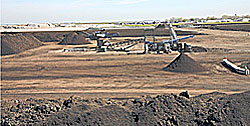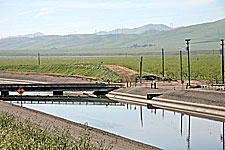 BioCycle August 2008, Vol. 49, No. 8, p. 39
BioCycle August 2008, Vol. 49, No. 8, p. 39
Grover Landscape Services processes up to 800 tons/day of yard trimmings and source separated food waste, producing high quality compost for landscape and agricultural markets.
L. F. Diaz and L. L. Eggerth
 GROVER Landscape Services, Inc. operates several composting facilities in northern California. Its site in Vernalis receives yard trimmings and food waste from various communities around the San Francisco Bay area, between 70 and 100 miles to the east. These include the City of Berkeley, portions of Alameda County, City of San Francisco, City of Livermore and others. Materials also arrive from the county of Sacramento, and communities near Vernalis. Grover transports about 2,500 tons/month of food residuals and yard trimmings from Berkeley to the Vernalis site, about a 140 mile round trip from the Berkeley transfer station to the composting facility. Total feedstock flow is between 400 and 800 tons/day, depending upon the time of the year.
GROVER Landscape Services, Inc. operates several composting facilities in northern California. Its site in Vernalis receives yard trimmings and food waste from various communities around the San Francisco Bay area, between 70 and 100 miles to the east. These include the City of Berkeley, portions of Alameda County, City of San Francisco, City of Livermore and others. Materials also arrive from the county of Sacramento, and communities near Vernalis. Grover transports about 2,500 tons/month of food residuals and yard trimmings from Berkeley to the Vernalis site, about a 140 mile round trip from the Berkeley transfer station to the composting facility. Total feedstock flow is between 400 and 800 tons/day, depending upon the time of the year.
The site officially opened in August 1999 on a 67-acre property. It consists of hard compacted clay soil sloped about one percent towards a drainage ditch. The ground water level is about 200 feet below the surface of the facility. The drainage ditch flows into a storm water collection pond.

Recently, an additional 57 acres were purchased, and the Grovers are in the process of securing permits. The new plot consists of an old paved air force runway and will be used for active windrow composting, Initial screening and grinding operations will be relocated there as that acreage is further away from the main road, and operators will be better able to control dust generation. Water for operations comes from the Delta-Mendota Canal. Water from the storm water pond is not currently recycled back to windrows, primarily because it is only full after heavy rains during the winter, when the windrows do not typically need additional moisture.
PREPROCESSING STEPS
Material is transported in transfer trailers owned either by Grover or by the entity requesting the service. Upon arrival, the load is weighed and then discharged in a specific area. The trailers either are equipped with walking floors or are tipped with specialized equipment.
The discharged material is spread with a front-end loader and formed into a large pile. As the material is dispersed, laborers manually remove visual contamination. The material is then processed through a McCloskey trommel with 3-inch screen holes; overs from the trommel are conveyed to a sorting station for additional removal of contamination, and then ground. Grover owns a Peterson 6700 horizontal grinder and a Diamond Z tub grinder, both with 1,000 HP diesel engines.
Food residuals – from residential source separated organics – comprise about 5 percent of the loads from the City of Berkeley. There is a small amount of soiled paper and waxed corrugated cardboard. The quantity of food residuals received has increased to the point where Grover is considering additional options to remove contamination on the front end.
Typically, the major type of contamination in all materials received are plastics (primarily plastic bags), although other items can be found in the loads of yard trimmings such as garden hoses, small electrical appliances, textiles, and rock and concrete. Because of the difficulty in identifying the various types of plastics that arrive at the facility, laborers remove all plastics including those that are biodegradable. About two 30-cubic yard containers of contamination per day are filled and have to be disposed at a landfill (estimated to be about 5 to 10 tons/day).
COMPOSTING, CONTAMINANT REMOVAL STEPS
After grinding, materials are formed into windrows with a C:N ratio of about 25-30:1 and moisture content of 50 to 60 percent. The windrows initially are about 6 feet high and about 14 feet wide. Grover makes a compost tea using several commercial brewers and its own compost. The tea is added to the newly formed windrows as an inoculant, which gets the process going more quickly. Temperatures in the windrows are monitored to ensure that they are within 135° to 160°F. The windrows are turned 20 to 25 times during a 10-week composting cycle.
Grover uses custom-built Aeromaster turners. It has four self-propelled units and several pull-behind turners. The company originally started with the pull behind. Pleased with the results, it asked Midwest Bio-Systems to build the self-propelled machines. The turners are equipped with nozzles and are connected via a hose to a water main so that water can be added during the turning process.
After 10 weeks in the windrows, the material is screened. The site has three Wildcat trommels (one is electric-powered) and a Power Screen. The company anticipates that it will switch to all electric-powered screens to comply with air quality rules. At this time, however, the local utility (PG&E) has not provided the power necessary to operate them. The site is in a remote area, and it may be months before the upgrades are completed.
Compost is screened to either 3/8-inch or 1/4-inch, depending on end use. Overs go through a number of steps to remove contaminants. They contain a large amount of rocks, some from the gravel at the site, but the bulk from the urban green waste stream. The rocks need to be removed before the overs can be reground, so they pass through a Flocait float tank where the rocks drop out.
To remove the lighter fraction – primarily film plastic – Grover uses air classifiers. It owns three Komptech Hurrikan air separators, and several Hawker Airlift separators. After these contaminant removal steps, the overs are ground and sold as different types of mulches, aged wood fines or as dairy bedding. Some of the processed overs also are sold as fuel for cogeneration.
EXPANDING MARKETS
The effort and investment put into contaminant removal on the front and back ends of the composting process have clearly benefited the quality of Grover’s compost products. The 3/8-inch and 1/4-inch screened material is called WonderGrow, which sells for about $18 to $25/ton. Another product called Eco-compost sells for about $12/ton. Grover also offers special mixtures to meet the needs of farmers, and can add lime and gypsum to the finished product.
In general, about 60 percent of the finished product is sold to landscapers and the rest to the agricultural sector. According to the owners of the facility, the finished product is completely sold out each year to customers near the facility, to those as far north as the Napa area and as far south as the Santa Barbara area. While organic farmers have utilized compost as part of their growing systems for years, the company is seeing more interest in the compost from conventional growers. The Grovers attribute it to the rising cost of petroleum-based chemical fertilizers, with farmers looking to compost to provide NPK. Key to this increasing acceptance has been continual education about compost benefits, and its ability to reduce the need for chemical inputs.
Luis Diaz, President, and Linda Eggerth, Senior Vice-President, are with CalRecovery, Inc. in Concord, California.
August 20, 2008 | General










